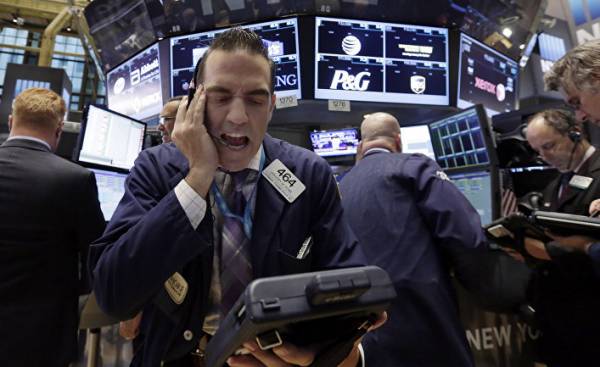
Can the President trump to fulfil their economic promises? For the next 10 years, his administration expects an annual growth of us GDP at 3.2%. Most analysts figures for significantly lower by about two percent. Such growth rates persist after the end of the 2007-09 recession years.
Usually the forecasts for the White house prepare highly qualified experts from the Council of economic advisers, which I headed in 2006-2009. As serious economists can turn a two-percent growth in the rosy picture that paints the administration, predicting more than three-percent growth? Answers to this question three. Productivity growth should return to the long-term average performance or be better. It is necessary to compensate for slowing labor force growth caused by the aging of the population. And third, tax cuts for the benefit of the investment must have a predictable positive effect.
To begin, we note that the growth rate of 3% is a long-term norm, not the exception. The average annual growth rate over the 30 years before the recession of 2007 was 3.1%. GDP growth is the sum of two terms: productivity growth and increase the total amount of working time. Usually the performance increases by about 2% annually, and the amount of working time by 1%. But in recent years, productivity growth slows down, and due to the aging of the labour resources amount of working time will not increase as quickly. That is why the congressional Budget office, the Federal reserve and other agencies give a forecast of economic growth of less than 2%.
To push this figure up, Trump will have to fight with the slowdown in performance. Between 2009 and 2016, the labor productivity in the non-agricultural sector increased overall by seven percent, which corresponds to one percent per year, or half the average for the time of accounting. But from 2001 to 2008 it increased by 18%, which corresponds to 2.3%. Perhaps this is partly just bad luck. The productivity growth jump up and down, and the average difference between performance for each year and average over 30 years is 1.2 percentage points. But seven years of low growth is bad luck of biblical proportions.
Productivity increases when improved technology and increased human capital of the employed population. The administration trump plans to make changes to the system of primary and secondary education K-12, which can lead to an increase in human capital. But even if successful it will be a slow process that is unlikely to dramatically increase the growth rate in a decade.
On the other hand, technologies are more sensitive to investment and improved when more resources are invested in research and development. This gives the property trump a good opportunity, as changing the tax structure, it can change and investment incentives. As I wrote in the pages of this publication, the best way to stimulate growth is to switch to consumption tax, since the full offset of capital against current expenditure. This will allow companies to deduct from their taxes the investment cost.
The classification of investments at the expense of current expenditures included in the proposals of the headquarters of the trump taxation. Under George Bush, the Ministry of Finance estimated that these policy changes will provide a permanent increase in GDP of 5%. The journal American Economic Review, predicted an even greater effect in 9%. Distribute these estimates for 10 years, and two-percent growth forecast suddenly turn into 2,5-2,9%.
Another brake on growth is the demographic changes. The social security administration predicts that in the period from 2020 to 2030 in the United States is not the increase of population in the age group from 20 to 64 years. And without increasing the total volume of working time be difficult to maintain a growth rate higher than 3%.
But the incentives of labor resources still exist. The share of employed working-age population in America during the recession and subsequent recovery has decreased from 63.4 by 59.9%. Biggest concern is the reduction by two percentage points among Americans aged 25 to 54 years. Partly to blame for this state policy, in which priority was given not work, and subsidized a life of leisure. One of such negative measures is the Law on affordable medical care. According to estimates of the congressional Budget office, Obamacare “in the period from 2017 to 2024 will reduce the total number of working hours (per year) for two and a half percent in the majority of cases, due to the fact that the workers do not want to work hard”.
According to forecasts, the number of Americans aged 65 years and older in the period from 2020 to 2030 will increase by 15 million people. And since life expectancy is growing, it is important to create incentives to ensure that these people continued to work. Here your contribution can make a difference in the structure of social benefits compensation to those who later retires.
In addition, the administration trump believes he can increase the demand for labor, eliminating burdensome rules and regulations for business. The white house has already started moving in this direction. With the growth of immigration increases the total amount of working time, but it seems that it is contrary to the course of administration.
If you return a historic achievement in performance, and also to take action for full compensation of the slow increase in the labor force, the economy returns to normal GDP growth of 3%. It’s unlikely, but possible, if we will have good luck on the technology front, and if it will be supported by favorable investment tax policies. But these “if” a lot. Need an active President, an active Congress and a little luck. It seems that trump is willing to work hard.
Edward Lazer led by the presidential Council of economic advisers from 2006 to 2009. He is currently a Professor in the graduate school of business Stanford University and a research fellow of the Hoover institution.







